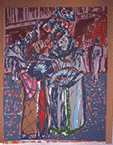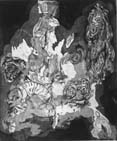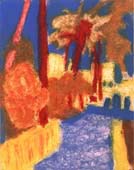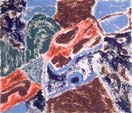Hit PAINTINGS to see some paintings Hit PRINTS FOR SALE to see more prints.
These are the methods...
|
SILK SCREEN PRINTING. ('Carnival of Venice' etc.) The screen is a wooden frame with an industrially stretched fine material over it. Various methods are employed to block areas of the material, so that the printing ink, when pushed through with a squeegee, will only pass through the remaining areas. These include a painted on filler and a photographic method whereby the artists own drawings are fixed onto a photosensitive gell and transferred to the screen. Each colour has to be printed separately and must fit exactly into the rest of the image, otherwise all the previous work is lost. The prints have up to fourteen layers of printing and they must be dried and the screens cleaned between each printing. Once the edition is finished this exact combination can never be repeated. |

Carnival of Venice (Screen Print, 14 layers) |
|

Waiting to Cross |
ETCHING employs various means of working on the surface of a metal plate, these marks hold the printing ink when rubbed into the plate and deposits the ink onto the dampened paper when put through a press. Some etchings involve aquatinting which means bonding a fine powder to the surface of the metal by heat. The fine lines are made with an etching tool through a rolled on 'ground', which protects the metal when emersed in the diluted nitric acid, the acid only penetrating where breaks have been made in the ground. The tones of grey or colour are achieved by first covering those areas to remain white with a stopping out solution before the first emersion, then 'stopping out' the pale grey thus achieved before the second emersion and continuing in this way for as many tones as required. Those never stopped out will print black. PHOTO-ETCHING ('Waiting to Cross') A template was prepared combining the artist's own drawings with treated photographs. A laser negative of this was exposed to a photosensitive plate and the plate then treated as described above. |

Civilisations |

Alcazar Garden (Collagraph on card) |
COLLOGRAPH.('Little House') Various materials are combined and attached to hard card as a base. In this case carborundum (which is like metal filings), string, plaster which hardens after being worked, tissue and acrylic glue. This is then hardened and left to dry. Ink can then be applied into (intaglio) or upon (relief) these surfaces and printed using a press or hand rubbing. |

Little House (Carborundum-on-zinc Collagraph) |
WOOD CUT ('Tragedy') The opposite of etching. The wood (or hardboard or plastic sheeting) is cut into & the ink stays on the surface. Sometimes, a woodcut is superimposed on a screen-printed background. Avis has also used Stone Lithography, not illustrated here yet... |

Tragedy (Woodcut) |
|
Why not e-mail me?
or go on to my PAST SHOWS pages
Back to my Index page
Back to the Art & Science Quick Index Page
Off to my Genealogy page
Contact: Avis Saltsman (or Saltzmann), 17 Gerrard Road, Islington, London N1 8AY +44(0)20 7359 6294 or e-mail me
URL: http://www.art-science.com/Avis/avis.html
Last revised 5/1/2009 Copyright: Avis Saltsman 1998 -2009
